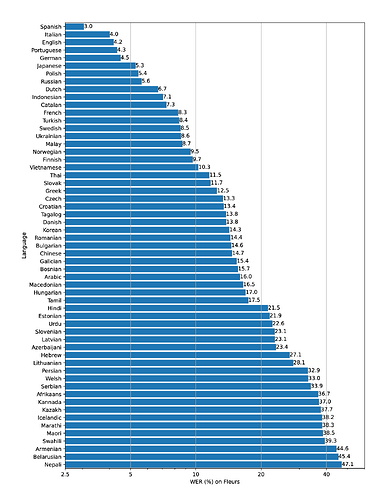關於 Whisper API
有誠意的 open source:
methods
Whisper API 有兩個 methods: transcriptions 以及 translations:
-
transcriptions: 辨識音檔後輸出文字。 支援語言 -
translations: 辨識音檔後輸出並翻譯成英文。
支援語言
The figure shows a WER (Word Error Rate) breakdown by languages of the Fleurs dataset using the large-v2 model.
來源:GitHub - openai/whisper: Robust Speech Recognition via Large-Scale Weak Supervision
價格
| Model | Usage |
|---|---|
| Whisper | $0.006 / minute (rounded to the nearest second) |
資料來源:Pricing
其他參考資料
使用 Whisper API
範例一
老師的範例,首先辨識 mp3 輸出為文字。
import os
import openai
openai.api_key = os.getenv("OPENAI_API_KEY")
- audio_file = open("Warren Buffett On Exposing Business Frauds And Deception.mp3", "rb")
- transcript = openai.Audio.transcribe("whisper-1", audio_file)
+ with open("Warren Buffett On Exposing Business Frauds And Deception.mp3", "rb") as audio_file:
+ transcript = openai.Audio.transcribe("whisper-1", audio_file)
# 看看輸出為何
print(transcript['text'])
Out(輸出)
I get letters all the time and I hear from people who have been taken…
接著將該文字檔,請 1️⃣ Section 11. ChatGPT API 幫我們作總結:
response = openai.ChatCompletion.create(
model="gpt-3.5-turbo",
messages=[
{"role": "system", "content": "You are an expert on Warren Buffett and good at creating summaries."},
{"role": "user", "content": f"Summarize the following transcript into key bullet points:\n{transcript['text']}"}
]
)
# 看看輸出為何
print(response['choices'][0]['message']['content'])
Out(輸出)
- People often get taken advantage of in financial transactions
- Frictional costs and unnecessary charges are a big problem
- …
提醒:
open是比較不好的寫法,建議使用with open代替。範例:with open(f"data/all_today_{today}.txt", mode=“w”, encoding=“utf-8”) as f:
大家可以參考這篇文章:
接著看看 github 的範例:
範例二
使用 transcribe() method
import whisper
model = whisper.load_model("base")
result = model.transcribe("audio.mp3")
print(result["text"])
範例三
使用較底層的 whisper.detect_language() 和 whisper.decode()
import whisper
model = whisper.load_model("base")
# load audio and pad/trim it to fit 30 seconds
audio = whisper.load_audio("audio.mp3")
audio = whisper.pad_or_trim(audio)
# make log-Mel spectrogram and move to the same device as the model
mel = whisper.log_mel_spectrogram(audio).to(model.device)
# detect the spoken language
_, probs = model.detect_language(mel)
print(f"Detected language: {max(probs, key=probs.get)}")
# decode the audio
options = whisper.DecodingOptions()
result = whisper.decode(model, mel, options)
# print the recognized text
print(result.text)
Whisper API 也支援 command line 指令:
whisper japanese.wav --language Japanese --task translate
REM 可以用下面這行指令來查看相關參數
whisper --help
自動切分 mp3
一、官方範例
避免在句子中間打斷音頻,因為這可能會導致某些上下文丟失。
處理方式之一是用 PyDub(Open Source) 來分割音頻:
以下是示範程式,如果加上檔案大小是否超過上限的檢查就更好了。不過我看程式,並沒有處理避免在句子中間打斷音頻這件事,那感覺 ChatGPT 的範例好一些。
from pydub import AudioSegment
song = AudioSegment.from_mp3("good_morning.mp3")
# PyDub handles time in milliseconds
ten_minutes = 10 * 60 * 1000
first_10_minutes = song[:ten_minutes]
first_10_minutes.export("good_morning_10.mp3", format="mp3")
來源:https://platform.openai.com/docs/guides/speech-to-text/longer-inputs
二、ChatGPT 示範
ChatGPT 寫的示範程式,將大於 25MB 的 mp3 檔案切分成小於 25MB 的多個 mp3 檔案(顯然會有上面提到的問題):
import os
import math
from pydub import AudioSegment
def split_mp3(source_file, output_prefix, chunk_size=25):
"""
將超過指定上限的 mp3 檔案切分成小於上限的多個 mp3 檔案。
Args:
source_file (str): 要切分的音訊檔案路徑。
output_prefix (str): 切分後的小檔案名稱前綴。
chunk_size (int): 指定上限大小 (單位:MB),預設為25。
Returns:
int: 切分成的小檔案數量。
"""
# 讀取音訊檔案
sound = AudioSegment.from_file(source_file, format="mp3")
# 計算要切分成幾個小檔案
num_files = math.ceil(len(sound) / (chunk_size * 1000 * 1000))
# 切分並儲存小檔案
for i in range(num_files):
start = i * chunk_size * 1000 * 1000
end = min(len(sound), (i + 1) * chunk_size * 1000 * 1000)
segment = sound[start:end]
output_file = f"{output_prefix}{i+1}.mp3"
segment.export(output_file, format="mp3")
return num_files
這個 function 接受三個參數:
source_file: 要切分的音訊檔案路徑。output_prefix: 切分後的小檔案名稱前綴。chunk_size(可選): 指定上限大小 (單位:MB),預設為 25。
該 function 會讀取 source_file 指定的檔案,如果其大小超過 chunk_size 指定的閾值,就會將其切分成小於 chunk_size 的多個 mp3 檔案,並命名為 {output_prefix}1.mp3, {output_prefix}2.mp3, {output_prefix}3.mp3 等等。最後,該 function 會返回切分成的小檔案數量。
測試看看:
num_files = split_mp3("source.mp3", "output", 25)
print(f"{num_files} files generated.")
程式將 source.mp3 切分成小於 25MB 的多個 mp3 檔案,並命名為 output1.mp3 , output2.mp3 , output3.mp3 等等。最後,程式會輸出切分成的小檔案數量。如果 source.mp3 的大小超過 25MB,這個程式會切分成多個小檔案,直到檔案大小都小於等於 25MB。如果 source.mp3 的大小已經小於等於 25MB,則該 function 不會進行任何操作,並返回小檔案數量為 0。
我只是先抄過來,還沒測試喔。
搞笑篇
因為懶得寫介紹,一開始試著請 ChatGPT 寫寫看。
按下 enter 後突然想起來,目前資料源訓練時還沒有 Whisper API…
然後就看它開始自顧自的唬爛。
Whisper API 是一個開放的 API,可以讓開發人員在他們的應用程式中使用匿名訊息功能。該 API 允許使用者將匿名訊息發送到其他使用者,而不需要透露自己的身份或聯繫方式。 Whisper API 也提供了安全性和隱私保護功能,以確保使用者的個人資料和訊息得到保護。
使用 Whisper API ,開發人員可以為其應用程式添加匿名聊天功能,這可以用於不同的應用場景,例如社交媒體、匿名提問箱或線上論壇。開發人員可以輕鬆地將 Whisper API 集成到其應用程式中,並通過提供使用者友好的界面來簡化使用。
使用 Whisper API 還可以提高使用者的參與度和互動性,因為它允許使用者通過匿名訊息進行交流和互動,而不必擔心被其他使用者識別。 Whisper API 已經被許多開發人員和企業廣泛使用,並且已經成為了許多應用程式的核心功能之一。
我順便幫大家選好配樂了!

